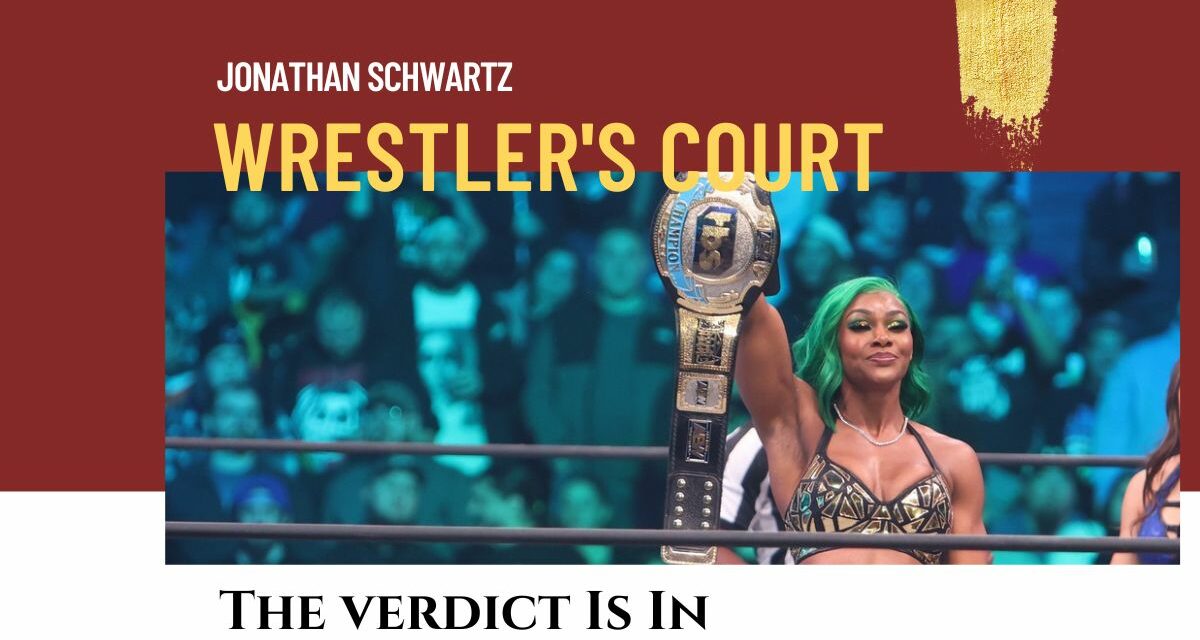On November 2, AEW aired its latest edition of Dynamite. The show featured four title matches and a few surprise reveals. One unsurprising result was TBS Champion Jade Cargill successfully defending her title and undefeated streak against former professional mixed martial artist and current enhancement talent Marina Shafir.
AEW makes frequent mention of Cargill’s undefeated streak, touting her as a future if not current megastar. It’s not hard to see why. While the Internet Wrestling Community is quick to point out her relative inexperience and occasional poor in-ring timing, Cargill combines an incredible look that borrows from comic book heroines like She-Hulk and Storm from the X-Men, with advanced, confident promo skills. She has proven an excellent foil for Tony Schiavone on interviews (Schiavone’s work has similarly made former AEW women’s World Champion Dr. Britt Baker a lynchpin of the division) and despite inconsistent pairings with managers like “Smart” Mark Sterling and Stokely Hathaway — both of which worked, but neither of which were necessary — and a revolving stable of “baddies”, she has made herself a person to watch on the AEW scene.
Cargill started wrestling in 2019, following a tryout at the WWE’s performance center. Mentored by Mark Henry she has trained under veterans including A.R. Fox, Heath “I Got Kids” Miller and QT Marshall.
Since signing with AEW in 2020, she has also worked extensively with Sonjay Dutt and Bryan Danielson. Her first official match took place in March 2021. She was thrown into the deep end, teaming with Shaquille O’Neal to beat AEW’s then unofficial gatekeeper Cody Rhodes and future Baddie Red Velvet.
Since then, Cargill has yet to be defeated. Within a year of her debut she won the TBS championship, besting Velvet, Thunder Rosa and Ruby Soho en route to the title, and since then has padded her streak against varied opposition including Anna Jay, Julia Hart, A.Q.A., Tay Conti and the aforementioned Shafir. Perhaps her highest profile recent victory came over a debuting Madison Rayne.
According to AEW’s website, Cargill’s record/streak currently stands at 39 wins against zero losses. And yet, despite the hype, it feels underwhelming. Cargill is not prominently featured on AEW’s flagship Dynamite and is currently mired in a feud with Nyla Rose, where the later has taken physical possession of her title belt. Rose is a former AEW champion but has a middling record and more importantly has not connected AEW’s audience in a meaningful way even with Vickie Guerrero as her manager. As streaks go, it’s all kind of meh.
Which raises the question of the value of streaks in wrestling and perhaps in sports more broadly. Done well, a win streak can help lift a performer from obscurity to superstardom or cement a legacy across decades. Done poorly, it diminishes the performer and negates their accomplishments. Streaks are funny things in wrestling, since who wins and who loses is determined backstage.
Streaks can begin by accident, the product of a promoter’s consistent choice to give a favored wrestler a victory.
One of the most famous streaks is The Undertaker’s series of 21 WrestleMania victories. Undertaker notched his first victory as a heel, beating Jimmy Snuka at WrestleMania VII in 1991. His last victory came against CM Punk in 2013 at WrestleMania 29. This streak carries its share of asterisks: early on, he beat Giant Gonzales by disqualification at WrestleMania IX to reach 3-0. Undertaker missed WrestleMania X and WrestleMania 2000 due to injury. He was originally scheduled to team with Nathan Jones vs. A-Train and Big Show at WrestleMania XIX but defeated both men in a handicap match instead. The streak would only be acknowledged and form part of storylines leading up to WrestleMania when Undertaker beat Ric Flair to go 10-0 at WrestleMania X-8 in Toronto (I was there). It wouldn’t become a focal point of WrestleMania until Randy Orton called it out in advance of WrestleMania 21. Notably, at the outset it wasn’t planned. WWE official Bruce Prichard has said that it was only acknowledged later, when bookers realized that Taker simply hadn’t lost — and WWE decided to roll with the momentum it brought.
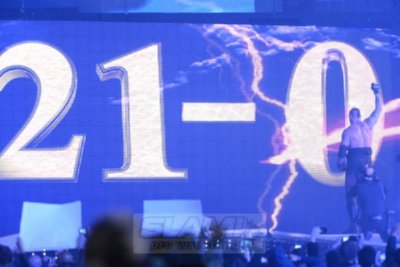
Undertaker leaves the grand WrestleMania stage undefeated for the final time. Photo by Mike Mastrandrea, www.mikemastrandrea.com
Undertaker’s streak is notable because of its association with a single annual event. Especially early in his career Undertaker would have fought hundreds of times a year; before he joined WWE he wrestled under other identities for WCCW in Texas, the USWA in Memphis and WCW across the Southern US, winning and losing matches and titles. While he certainly won more than he lost as the Deadman, he came up short on house shows and numerous other pay-per-views. His WrestleMania streak is notable for his longevity and the fact that for a long time he’d win on one particular evening — whether or not the matches themselves were significant or good.
By contrast, Goldberg’s WCW win streak was planned from the outset and the streak defined his character almost from his debut in 1997. It was heavily kayfabed but made him a breakout character and one of the few WCW transplants who was able to succeed (albeit much later, on very different terms) in today’s WWE. Goldberg’s streak turned him into a main eventer within a year of his debut.
Debuting in a Nitro dark match under the name of Bill Gold, Goldberg’s first victory came against trainer Sgt. Buddy Lee Parker in June 1997. He would soon beat Buddy Landell, Hugh Morrus and some lesser known talent before losing (gasp!) to Chad Fortune in an unacknowledged dark match in July. He would make his official debut in September. Goldberg’s streak was integral to his character; the power moves and intense, short matches covered his lack of experience, much the same way as they did for the Road Warriors of the early 1980s. As the victories piled up (real and imagined) the crowd grew wilder.
After beating most of the roster, Goldberg would win his first title in April, 1998, beating Raven for the WCW United States Championship. This seems to parallel where we find Ms. Cargill, although within three months Goldberg would beat Hulk Hogan to preserve his streak and win the WCW World Heavyweight Championship, while Cargill seems to be treading water with her secondary title.
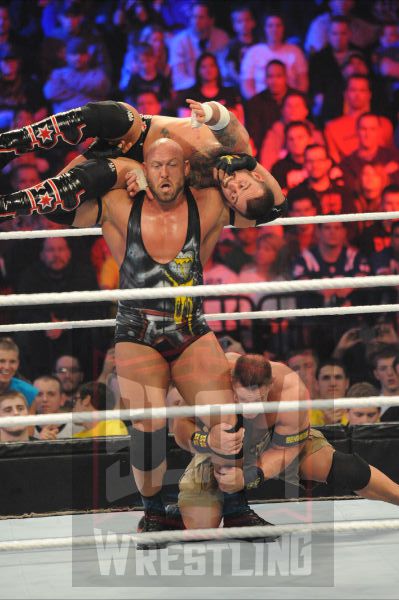
Ryback has CM Punk in his arms as John Cena goes after his legs at Survivor Series 2012. Photo by Mike Mastrandrea, www.mikemastrandrea.com
Streaks don’t always work. WWE used similar gimmicks to establish Brock Lesnar as a monster in 2002. That went well. Ryback’s 2012 streak not so much. Asuka ran through opponents in her 2017 NXT run, but was immediately defeated by Charlotte Flair at WrestleMania in her first high profile main roster match. One wonders if the latter would have happened today given the push for better integration between NXT and Raw/Smackdown in the McMahon Helmsley Era.
Well before Undertaker’s streak was established or Goldberg ran through WCW’s locker room, Chris “Tatanka” Chavis received a series of tryout matches with the WWF in early 1991, beating Dale “Dusty” Wolfe, the Brooklyn Brawler, Skinner and others. He formally debuted in February, 1992 beating Pat Tanaka. Tatanka was heavily pushed as undefeated although this was largely kayfabed as well. Tatanka wasn’t pinned or submitted on TV but he is reported to have lost several matches at house shows, often via countout or disqualification.
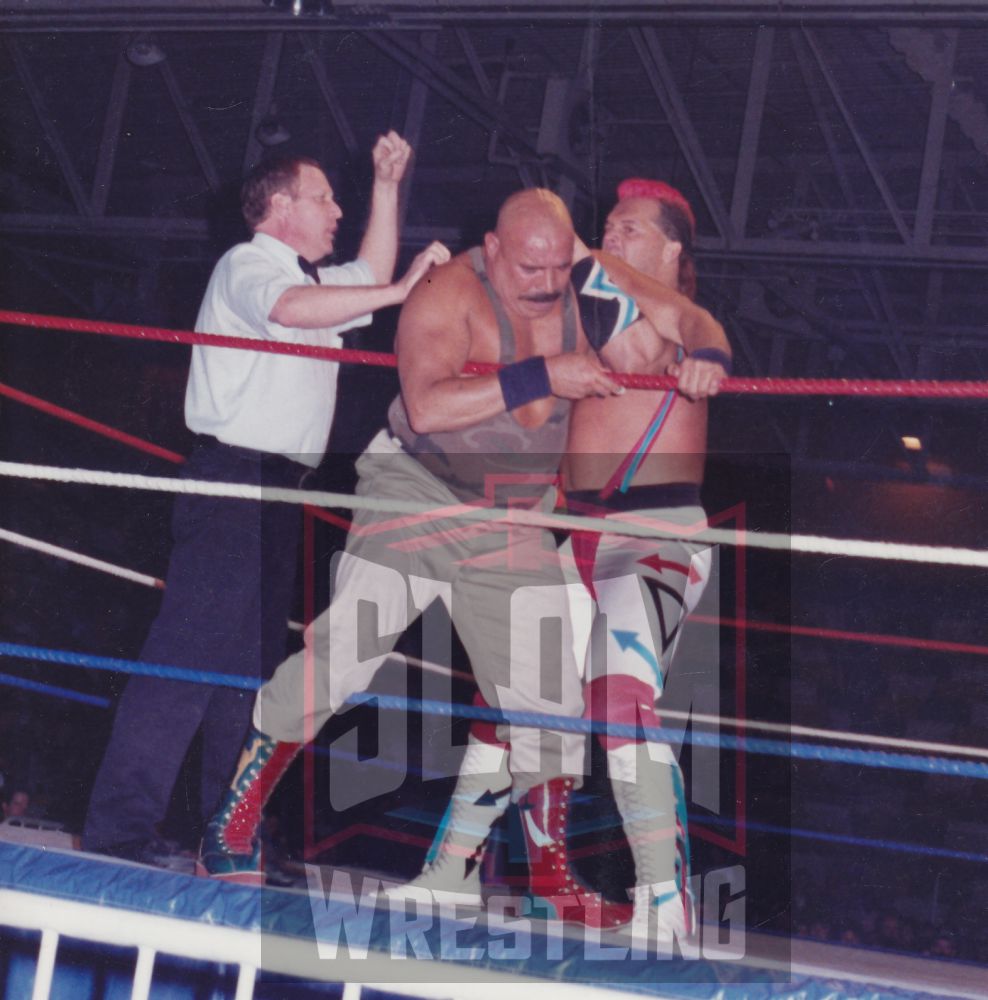
Tatanka faces Col. Mustafa / Iron Sheik at a WWF house show in London, Ontario. Photo by Terry Dart
Tatanka’s streak differs from Undertaker’s or Goldberg’s in that, looking back, it seems that it existed for its own sake. WWF announcers would call it out in general terms as Tatanka beat enhancement talent after enhancement talent, but these victories did little to give him any real storyline momentum. Tatanka would spend most of the streak in a series of mid-card feuds, often where the heel would insult his First Nations heritage. His first WrestleMania match would be a victory over Rick “The Model” Martel, with whom he would feud off and on through that year’s Survivor Series. Never a world championship contender despite being undefeated, his highest profile match was likely an Intercontinental title match at WrestleMania IX against Shawn Michaels. Tatanka won the match by countout but did not win the belt. In fact, neither of Tatanka’s full-time WWE runs (1991-1996 and 2005-2007) saw him win any kind of title.
Tatanka’s streak would end ignominiously at the hands of heavily pushed white supremacist drug addict, Ludvig Borga. After the match Yokozuna would attack and put Tatanka out of action for three months. A planned rematch against Borga at the 1994 Royal Rumble would never take place. Borga had injured his ankle and would never appear for WWF again. Whatever value Tatanka’s streak may have had was squandered; he would turn heel by the summer and bounced around the lower mid-card as part of the Million Dollar Corporation stable until leaving WWE in 1996. Unusually he was never signed by WCW or ECW, working sporadically on the independent scene until a 2005 one-off appearance against Eugene on Raw turned into a longer stint helping put over new talent. Whatever favors his undefeated run was supposed to do, it seems clear that management was not committed to a run to the top of the card.
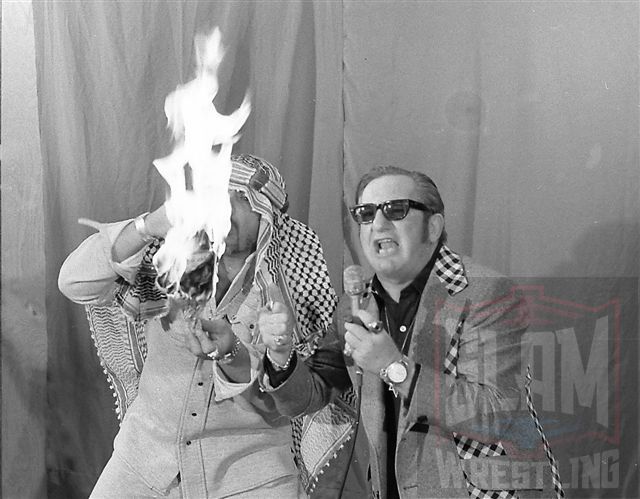
The Sheik and manager Eddie “The Brain” Creatchman. Photo by Dave Drason Burzynski
Toronto had its own streak back in the territory days. The Sheik was a mainstay for Frank Tunney’s promotion starting in 1969, going undefeated at Maple Leaf Gardens for 127 matches and defeating legends and ‘serious’ wrestlers like Whipper Watson, Lou Thesz, Gene Kiniski, Bruno Sammartino (whose decades long WWWF title reigns were peppered with disqualification and countout losses as a way of establishing his vulnerability against dastardly monster heels), Edouard Carpentier, Ernie Ladd, Chief Jay Strongbow, fellow madman and Bramptonian Tiger Jeet Singh, Johnny Valentine, and a young Andre the Giant. Sheik’s streak ended in 1974 on a technicality. He was disqualified against Andre, but only took his first pinfall losses two years later in 1976, to Thunderbolt Patterson and eternal nemesis Bobo Brazil. In his heyday, Sheik was a bona fide wildman and a huge attraction across the Northeast (he was decidedly less welcome in the Midwest and Southern US and was run out of Sam Muchnik’s St. Louis promotion — and thus much of the NWA — for his reliance on blood and fire and theatrics over sound technical wrestling). However, his popularity waned and the last few years of this streak were marked by declining revenues and smaller audiences. It may be coincidental that Sheik was the promotion’s booker starting in 1971.
A streak can be broken in any match at the promoter’s whim. However supportive the audience may be during a streak, the decision to end it will often engender controversy. Fans are divided on WWE’s decision to end The Undertaker’s streak at Brock Lesnar’s hands at WrestleMania XXX. I think it was a mistake even though it produced a genuine “I remember where I was” moment of wrestling fandom and a host of memes. In my own case I was at the movies, watching Ryan Reynolds’ cinematic opus Green Lantern that night. I checked my phone on my way out of the theatre and was gobsmacked by the result. Lesnar may have been one of the few men who could credibly beat The Undertaker, but by that point he was a multi-time two-sport champion and established as a killer (who had benefitted from his own streak upon his 2002 debut). Lesnar didn’t need the win to cement his legend, even though manager Paul Heyman made it a standard part of his schtick ever since. Roman Reigns would drop Taker to 32-2 a few years later as part of WWE’s plan to make him a main event player, but he too had already been pushed to the moon before a hostile audience.
The value of the streak had also been diminished by that point due to The Undertaker’s relative inactivity. Latter-day opponents like Shawn Michaels, Triple H and CM Punk had to carry their feuds with Undertaker into their matches. As Undertaker made fewer and fewer appearances on Raw and Smackdown these opponents would resort to endless callouts and vignettes to build interest. For the most part they worked due to the performers’ charisma, but as boxing and MMA fans know there’s nothing like a face to face or pull-apart brawl leading up to a big show.
I still think that honor should have gone to someone with more upside. A loss to Bray Wyatt would have made the latter and created a new supernatural superstar. We may be headed that way anyway now, but it’s a decade later without a real passing of the torch.
Goldberg’s cattle prodding loss to Kevin Nash is often cited as one of the many poor decisions by WCW booking which led to its demise. Nash himself has taken some of the heat; he was a member of the booking committee during a fractious period in WCW’s history, and one of many established stars who had come over from the WWF, and was seen to be preventing younger or homegrown WCW stars from reaching their potential. Goldberg would continue to be booked as dominant, but without the original streak, it seemed he had lost something. A feud that saw him beat Sid Vicious (whose gimmick included a drastically inflated win streak of his own, played for laughs) and an attempt to reconstitute his momentum under Vince Russo’s thumb fell flat.
Goldberg would eventually head to the WWF following WCW’s collapse, but WWE’s different booking style and heavier expectations on him as an in-ring performer to work longer, competitive matches made for a poor run overall. It wouldn’t be until he returned to WWE in 2016 with a different attitude and a more cooperative WWE front office that he regained form; while he lost more frequently (which would be expected of any athlete as he neared his 50s) he still won a few titles — although increasingly to fans’ chagrin.
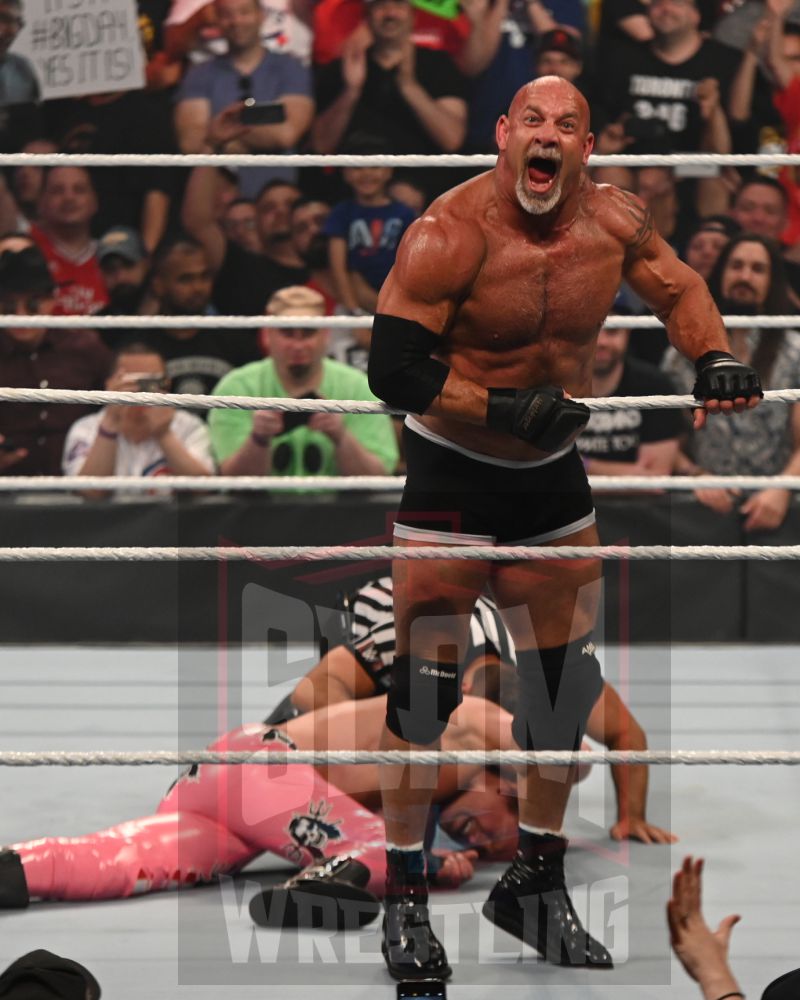
Goldberg defeated Dolph Ziggler at SummerSlam 2019 in Toronto. Photo by Joe Hrycych, www.hrycychphotography.com
As mentioned, Tatanka’s streak never seemed to give him the momentum to make it into the world title picture. His loss to Borga was similarly uninspired. He was removed from television and came back without a ready feud since Borga was injured and subsequently released. As long as it lasted, it never defined Tatanka as a performer as much as WWE’s insistence on positioning him as an ‘ethnic’ hero like former First Nations performers (some real, most imagined like Chief Jay Strongbow…but that’s a different column). The Sheik’s streak ended on a technicality, which diminished his later, real losses.
One of the central challenges of a pro wrestling winning streak is that the wrestler who carries it needs to be strong enough for fans to believe he or she can win, but vulnerable enough for the audience to wonder whether this is the match that will see their favorite be defeated (and buy tickets accordingly). This has been one of the main flaws in Cargill’s streak. To make Cargill’s streak mean something AEW needs to balance the flow of enhancement talent sacrificed at her altar with occasional top tier contenders.
In real sports terms, it’s the difference between Rocky Marciano, who retired undefeated at 49-0 after a career fighting the best available opponents (although Marciano is not considered an all-time great; he fought at a time when the pool of contenders was weak) vs. Floyd Mayweather Jr., who fought in an era that promised greater competition, but who was routinely accused of ducking top contenders, waiting until they passed their primes, and otherwise fought a safe style designed not to lose, rather than a more exciting, riskier style.
A streak can become a crutch, and the truth is that inside the ring or outside sooner or later everything ends. Just showing up for work can be an invitation to end a streak. Cal Ripken’s baseball iron man streak ended because he took himself out of the lineup. Joe DiMaggio’s 56-game hitting streak will last until someone makes contact for one extra game… likely with a host of asterisks appended thereto.
From a promoter’s perspective, a streak is a useful marketing tool, but as fans it is ultimately a distraction from what we’ve been most conditioned to care about: the chase for or defence of championships. This is why we talk about Goldberg’s meteoric rise decades later, and not Tatanka’s run. Undertaker’s WrestleMania streak showed that well into his career, on one night he could still show the world what he could do. Without it, his body of work still stands.
Who knows here Jade Cargill ends up on this spectrum? She’s still relatively new to the business and has everything going for her, including the support of AEW management. I dislike her current storyline but if it stands to turn her face it offers her a chance to renew her momentum against a different group of opponents, and maybe give us the superstar we want.
TOP PHOTO: Jade Cargill and the TBS Women’s title, on AEW Dynamite, which aired on April 29, 2022. Photo by George Tahinos, georgetahinos.smugmug.com
RELATED LINK
JADE CARGILL LINKS
- Sep. 26, 2023: Jade Cargill: ‘I want to wrestle with the best women in the world’
- Sep. 26, 2023: Khan praises Cargill, criticizes WWE layoffs
- Sep. 26, 2023: WWE signs Jade Cargill
